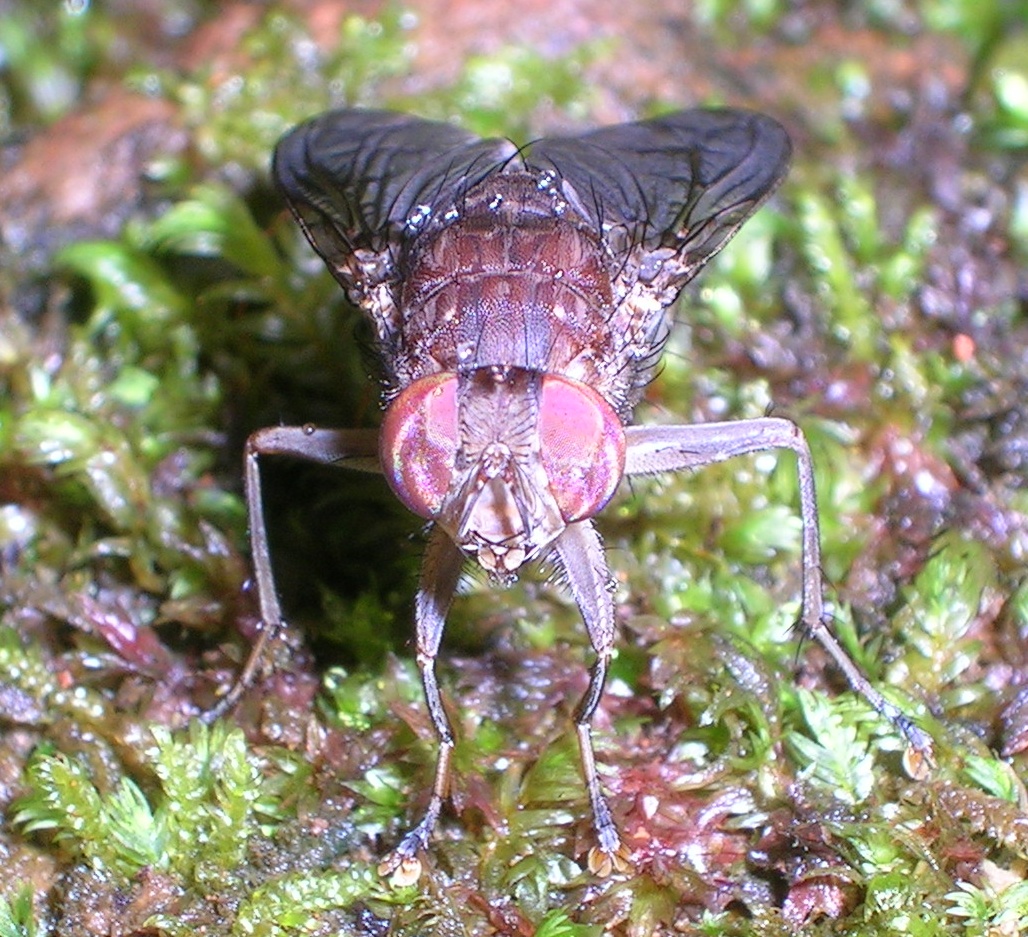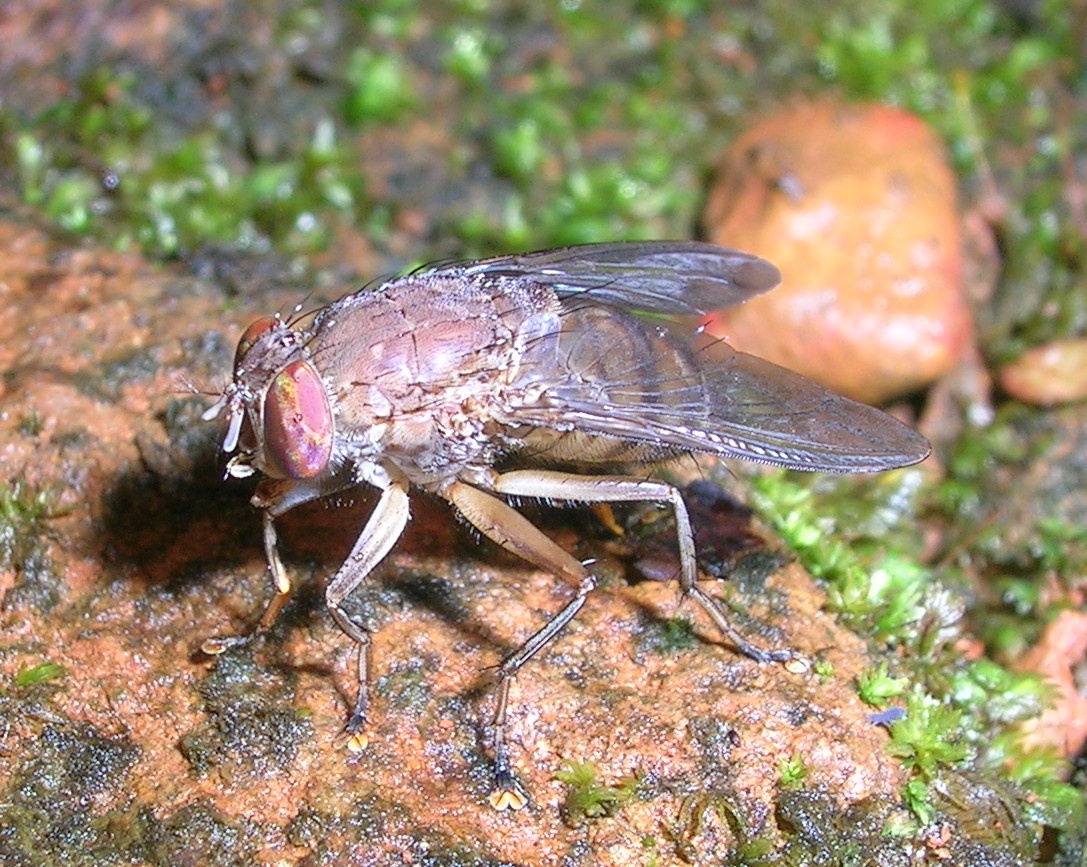- Bengalia

regnum =Animal ia
phylum =Arthropod a
subphylum =Hexapoda
classis =Insect a
subclassis =Pterygota
infraclassis =Neoptera
superordo =Endopterygota |
ordo = Diptera
subordo =Brachycera
infraordo =Muscomorpha
zoosubsectio =Calyptratae
superfamilia =Oestroidea
familia =Calliphoridae
subfamilia =Calliphorinae
tribus =Calliphorini
genus = "Bengalia"
genus_authority = Robineau-Desvoidy, 1830
subdivision_ranks = Species
subdivision = >40 species, number in dispute, see text"Bengalia" is a genus of blow flies in the family Calliphoridae with one authority considering the genus to belong to a separate family BengaliidaeLehrer, A.Z., 2003, Bengaliidae n. fam. Une nouvelle famille de Diptera Cyclorrhapha. Entom. Croat., 7(1-2) :5-14.] These bristly and, unlike the greens and blues of most calliphorids, dull coloured flies, are especially noted for their relationship to ants. Adults of many species are kleptoparasitic on ants and will snatch food and pupae being carried by ants or feed on winged termites. [Sivinski, J., S. Marshall and E. Petersson (1999) Kleptoparasitism and phoresy in the diptera. Florida Entomologist 82(2) [http://www.fcla.edu/FlaEnt/fe82p179.pdf] ] [Bequaert,J. 1922. The predaceous enemies of ants. Bull. Amer. Mus. Nat. Hist 45:27 l-331. [http://hdl.handle.net/2246/1934] ]
Description
Most of the species have a yellow or brown ground-colour, an antero-posteriorly compressed head, stout mouthparts, a projecting clypeus below the lower facial margin and have a silent flight. Very little is known about their breeding habits. The genus is found in the Afrotropical and oriental region with one species from Australia possibly a recent introduction.
pecies
The following is a partial list of species in the genus: [ [http://data.gbif.org/species/browse/taxon/13168968 GBIF] ] [ [http://www.catalogueoflife.org/browse_taxa.php?selected_taxon=33712 Catalogue of life] ]
*"B. africana" Malloch, 1927
*"B. aliena" Malloch, 1927
*"B. asymmetria" Kurahashi & Tumrasvin, 1979
*"B. bezzii" Senior-White, 1923
*"B. calilungae" Rueda, 1985
*"B. chiangmaiensis" Kurahashi & Tumrasvin, 1979
*"B. chromatella" Séguy, 1946
*"B. concava" Malloch, 1927
*"B. cuthbertsoni" Zumpt, 1956
*"B. depressa" Walker, 1858
*"B. escheri" Bezzi, 1913
*"B. fuscipennis" Bezzi, 1913
*"B. gaillardi" Sourcouf & Guyon, 1912 - 'Synoyms:"B. spurca" Brauer & Bergenstamm, 1891, "B. spurca" Villeneuve, 1914
*"B. hastativentris" Senior-White, 1923
*"B. hobbyi" Senior-White, 1940
*"B. inermis" Malloch, 1927
*"B. kanoi" Kurahashi & Magpayo, 2000
*"B. labiata" Robineau-Desvoidy, 1830
*"B. lyneborgi" James, 1966
*"B. martinleakei" Senior-White, 1930
*"B. minor" Malloch, 1927
*"B. pallidicoxa" Senior-White, 1946
*"B. peuhi" Villeneuve, 1914
*"B. pseudovaricolor" Kurahashi & Tumrasvin, 1979
*"B. recurva" Malloch, 1927
*"B. robertsi" Kurahashi, 1987
*"B. roubaudi" Rickenbach, Hamon & Mochet, 1960
*"B. siamensis" Senior-White, 1924
*"B. spinifemorata" Villeneuve, 1913
*"B. spissa" Walker, 1858
*"B. subnitida" James, 1964
*"B. surcoufi" Senior-White, 1923
*"B. taiwanensis" Fan, 1965
*"B. tibiaria" Villeneuve, 1926
*"B. unicolor" Senior-White, 1946
*"B. varicolo" Fabricius, 1805
*"B. xanthopyga" Senior-White, 1924Taxonomic dispute
The monophyly of the taxon is not in dispute, but the decision to accord the taxon the rank of family is, however, disputed by Rognes (2005) who notes that it is equivalent to the already established tribe Bengaliini, and that treating it as a family renders the Calliphoridae
paraphyletic .Rognes, K. 2005. Bengalomania – A review of Andy Z. Lehrer's book on Bengalia Robineau-Desvoidy, 1830 and related works (Diptera, Calliphoridae). Studia dipterologica 12: 443–471 [http://home.chello.no/~akrognes/Bengalomania.pdf] ] Further, the genus was divided into 11 genera in 4 subfamilies by Lehrer in 2005, [Lehrer, A.Z. (2005) Bengaliidae du Monde (Insecta, Diptera). Pensoft Series Faunistica No. 50, Sofia, Moscow. ISSN 1312-0174] with these genera being sunk back into "Bengalia" by Rognes shortly thereafter. Prior to Lehrer's revision, there were 41 described species; Lehrer described an additional 49 species, 18 of which were treated as invalid by Rognes. At present, authoritative sources of Dipteran taxonomy do not recognize Lehrer's 10 new genera as valid, nor the 18 new species treated as invalid by Rognes (e.g. [Thompson, F. C. (editor). 2006. Biosystematic Database of World Diptera. [http://www.sel.barc.usda.gov/Diptera//biosys.htm] , accessed on 9 Nov. 2007] ).This dispute reflects that at present, there is no consensus as to the best way to subdivide the Calliphoridae, which many authorities acknowledge is not a natural group (in this case,
polyphyletic ); the BioSystematic Database of World Diptera, for example, states "The Calliphoridae are marked as a polyphyletic group of convenience as at the present we are unwilling to reduce the Oestridae to a subordinated group within a monophyletic Calliphoridae nor to elevate a number of other groups (Polleniidae, Helicoboscidae, and Bengaliidae) so as to properly delimit both Calliphoridae and Oestridae." [http://www.sel.barc.usda.gov/Diptera/names/FamClass.htm] Similarly, the dispute at the generic level is that some of Lehrer's genera are paraphyletic, and, additionally, that they are based largely or exclusively upon features of the male genitalia, and it is therefore impossible to identify most female specimens to subfamily, let alone genus (the rejection of Lehrer's subdivisions therefore being both taxonomic and a matter of practicality). The dispute at the species level centers on the fact that Lehrer did not include or examine 24 of the 41 known species in his revision, so of the 31 species he validly described that were not immediately synonymized, many could still "potentially" be synonyms of these 24 excluded species.References
Wikimedia Foundation. 2010.

